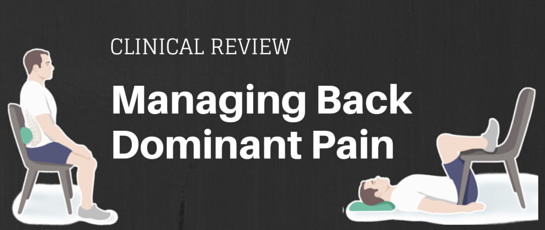The Latest in Back Pain Management

It's Time for a Different Approach
In spite of great effort, low back pain (LBP) remains a significant burden on society and one of the most common reasons to see a primary care provider. The conventional medical message about acute LBP is inconsistent with its actual clinical course. There is little agreement on the cause or best treatment. Back pain is "over-medicalized." Routine care is fragmented and episodic. We propose shifting to a practical, stratified approach based on rapid clinical recognition of mechanical syndromes with early identification of psychosocial issues and potentially serious pathologies. LBP is a chronic condition; the goal is control, not cure.

Making Sense of Low Back Pain
In 1987, the Quebec Taskforce noted, "Distinct patterns of reliable clinical findings are the only logical basis for back pain categorization and subsequent treatment." Identifying these patterns begins with the patient's history: "Where is your pain the worst?" "Is your pain constant or intermittent?" "Has there been any change in your bowel or bladder function?" This questioning establishes the mechanical nature of the pain, and a physical examination verifies or refutes the pattern established in the history. The examination involves two essential tests to detect upper motor and low sacral root involvement. A failure of the results to fit into one of four syndromes—two back dominant and two leg dominant—suggests a non-mechanical or more complex problem.

Managing Back Dominant Pain
Back dominant pain is either intensified by flexion or is not aggravated by bending forward. The most common pattern, probably discogenic, subdivides into two groups: one with pain on flexion but relief on extension, the other with pain in both directions. The second pattern has symptoms with extension only. Treatment begins with education about the true benign nature of the problem. Mechanical pain responds to posture adjustment and pattern-specific movement. Medication has a secondary role. Imaging is not required for the responding patient. The inability to detect a pattern or a lack of anticipated response combined with non-mechanical findings indicates the need for appropriate referral.

Managing Leg Dominant Pain
Leg dominant pain suggests direct nerve root involvement: radicular, not referred symptoms. Constant pain associated with positive neurological findings usually results from an acute disc herniation. Symptoms are the result of mechanical compression but principally reflect an inflammatory response, properly designated sciatica. Intermittent leg dominant pain triggered by activity in extension and relieved by rest in flexion probably represents neurogenic claudication: nerve root ischemia secondary to spinal stenosis. Except for acute cauda equina syndrome, acute sciatica is initially managed with scheduled rest, adequate medication, and time. Non-responsive cases may require surgery. Surgery also shows superior outcomes for disabling neurogenic claudication.


